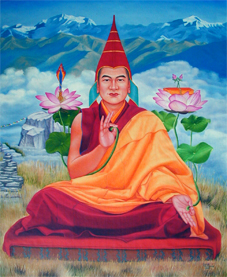 Dharmakirti was a seventh century Buddhist scholar and a founder of Indian philosophical logic. Dharmakirti taught at Nalanda, an ancient university in India that boasted thousands of students. Part of the curriculum consisted of oral discussion and debate. I found reading his Vadanyaya to be interesting in terms of observing the development of logic outside of the well-known European tradition. Studying logic in general is always profitable whether we are interested in philosophy or in history.
Dharmakirti was a seventh century Buddhist scholar and a founder of Indian philosophical logic. Dharmakirti taught at Nalanda, an ancient university in India that boasted thousands of students. Part of the curriculum consisted of oral discussion and debate. I found reading his Vadanyaya to be interesting in terms of observing the development of logic outside of the well-known European tradition. Studying logic in general is always profitable whether we are interested in philosophy or in history.
Dharmakirti says at the beginning of his work: “The wicked persons defeat even the one who argues rationally in debates by employing improper methods. We start this (work on the logic of debate) for repudiating them.” Dharmakirti thus believes that the disputant and opponent should not be desirous for victory but should rather want to correct misconceptions, to state the argument rationally, and to refute any irrational argument.
What follows is a description of Dharmakirti’s Vadanyaya, the “Logic of Debate.”
Nigrahasthana is the occasion of defeat (what we would call a fallacy). There are nigrahasthanas of the disputatant (Asadhanangavacana) and of the opponent (Adosodbhavana).
Nigrahasthana
Of the disputant (Asadhanangavacana)
N1 Non-justification of a constituent of proof (invalid premise)
N2 Non-statement of a constituent of proof (omitted premise)
N3 Statement of what is redundant as a part of proof (circular argument)
N4 Statement of a fallacious constituent of proof (invalid inference)
N5 Statement of something irrelevant (red herring)
Of the opponent (Adosodbhavana)
N6 Not pointing out a fault in disputant’s argument
N7 Pointing out a non-fault as fault
Sadhana is the proposition intended to be proved by the disputant. Its anga are the contents of the proof.
A probans is an inferential sign, and a probandum is the predicate of the proposition that is inferred (conclusion). A proof contains two statements, according to Dharmakirti: the statement of paksadharmata, which says that the probans exists in the subject, and statement of vyapti, which says that whatever has probans, has probandum. This is a very close parallel to the Aristotelian syllogism, “Socrates is a man; All men are mortal; therefore, Socrates is mortal.”
Dharmakirti gives this example of a proof, “All that is real or is a product is impermanent, like things such as a pot. And sound is real or is a product.” Here the statement of paksadharmata (an Aristotelian minor premise akin to “Socrates is a man”) is “Sound is real or is a prduct,” and the statement of vyapti (an Aristotelian major premise akin to “All men are mortal”) is “All that is real or is a product is impermanent, like things such as a pot.” There is no rule about the order of these premises.
There are three types of probans: self-nature, effect, and non-apprehension. The above example is an example of the probans of self-nature. Proving pervasion, vyapti, involves proving the non-existence of probans if assuming the non-existence of probandum (my interpretation: proving A->B by proving ~B->~A or by proving A&~B to be a contradiction). For example, assume that something which is real or is a product is not impermanent (assume A&~B). The definion of impermanent is momentariness, being subject to destruction at any moment. The defining characteristic of the real is “capacity to function” either in succession or in simultaneity. If something has the capacity to function, either in succession or in simultaneity, it is momentary. So, by the assumption, the thing is momentary by virtue of being real or a product and non-momentary by virting of being not impermanent. This is a contradiction, and the pervasion of “All that is real or is a product is impermanent” is demonstrated.
In the case of effect-as-reason, a constituent of proof needs justification. It is the establishment of a cause-effect relation between probans and probandum where the effect is used as probans for proving the cause. This is done by giving two kinds of evidence (pramanas), one establishing positive concomitance and the other negative concomitance, such as “This (e.g. smoke) occurs when this (e.g. fire) exists,” and “this (e.g. smoke) does not occur in the absence of this (e.g. fire).”
Non-apprehension as a reason may establish non-existence, if the object fulfills the conditon of apprehensibility by the knower. The specific nature of the object must be such that it is not remote from the senses due to any of the three kinds of remoteness: remoteness in space, remoteness in time, and remoteness by self-nature of the object.
This completes my short summary of Dharmakirti’s “Logic of Debate.”
[…] I’m sure some wonder why I would include a summary of Dharmakirti Logic of Debate in my last post. It’s primarily because I want to preserve this information for those […]